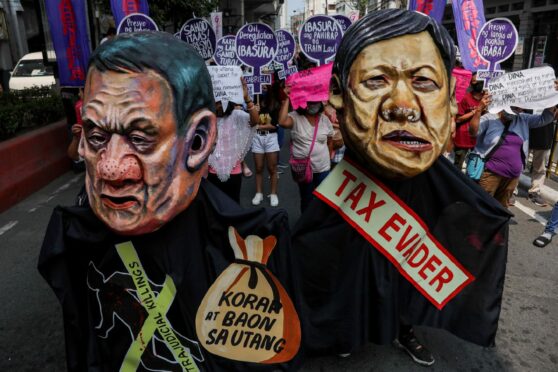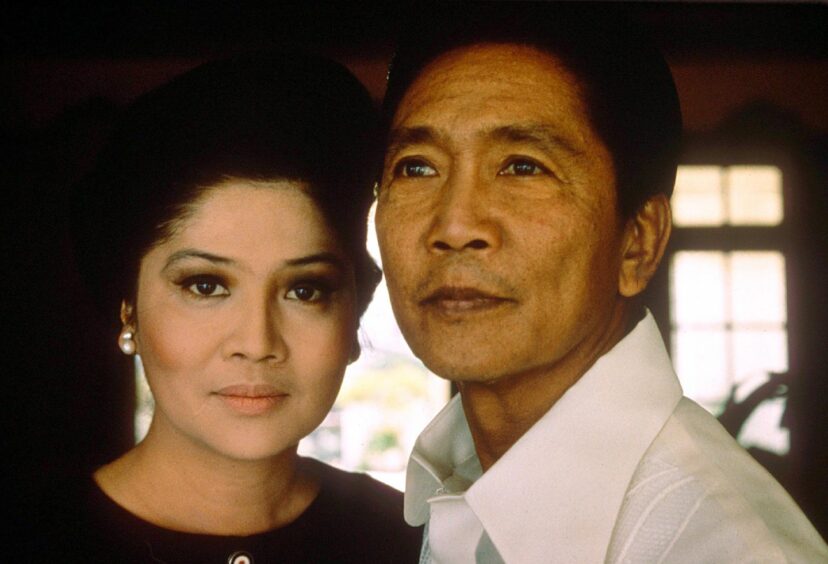
When Ferdinand and Imelda Marcos flew into exile in 1986 to escape a popular revolution in the Philippines, they plundered treasure worth $15 million.
The US Customs record when the couple arrived in Hawaii ran to 23 pages and included enough clothes to fill 67 racks, 413 pieces of jewellery, 24 gold bricks inscribed with dedications to each other and 27 million in freshly printed Philippine pesos.
The First Lady, known as the Iron Butterfly during her husband’s 21-year rule, left her collection of 3,000 pairs of shoes back in Manila.
None of the victorious crowds could ever have imagined that, 36 years later, the dictator’s son, Ferdinand Marcos Jr, could be poised to become president.
Marcos Jr has maintained a strong lead over rivals in the run up to the Philippines’ presidential election on May 9, according to opinion polls.
Marcos Jr, known as Bongbong, has captured 60% of support, according to a poll published on Monday by independent pollster Pulse Asia. In contrast his closest rival Leni Robredo, the current vice-president, slid from 16% to 15% in ratings.
Outgoing President Rodrigo Duterte was a “strongman” leader whose controversial six-year rule has been marked by a police crackdown on drug suspects, leading to the deaths of 6,000 people. The International Criminal Court has begun an investigation into what an ICC prosecutor said could be crimes against humanity.
Bongbong has stunned analysts by storming the opinion polls. Commentators say his appeal is strongest among wealthy Filipinos and the poorest in this society of 111 million people. They like his simple message: unity.
The politics of nostalgia and the efforts of a campaigning digital battalion downplaying the excesses of his parents are said to have helped Marcos Jr to the edge of power. A younger generation, which did not live through the dictatorship, seems not to care for the past, say analysts.
Richard Heydarian, a policy adviser and chair of geopolitics at the Polytechnic University of the Philippines, believes voters are willing to tolerate an authoritarian figure. “Research shows people will put up with strong men if they think these leaders will get things done,” he said.
However, faced with this prospect of a Marcos returning to the Malacanang Palace, something extraordinary is happening: priests representing the largest Roman Catholic Church in Asia have forsaken neutrality and turned political.
Wearing a pink bracelet on their wrists – the colour of Marcos Jr’s biggest rival – some priests have joined political rallies. “We must do all we can to stop another Marcos running this country,” Father José García, of the St Vincent de Paul Church in Manila, told The Sunday Post. “It would be a betrayal of all those who fought Marcos’s father. ”
Father García drives around in a van emblazoned in pink with the slogan: “Pray and Choose Wisely. Your future depends on it.”
Back in 1986, the Catholic Church championed a “People Power” uprising with the military that overthrew Marcos’s father. During the dictatorship, thousands who opposed the president’s rule were killed and tortured.
If Marcos Jr, an Oxford-educated former congressman and senator, wins the presidency it will be a remarkable comeback for a family accused of one of Asia’s most notorious kleptocracies. During two decades in power Marcos Sr amassed a fortune estimated by the Philippine supreme court to be $10 billion. Officially, the president was paid a salary of $13,500 so it was obvious this fortune came from stealing from the state. The Philippines is a country where 40% of the population survives on less than $2 per day.
After the chaotic revolution, the country decided to claw back some of the money the Marcos family and its cronies stole. The Presidential Commission on Good Government has spent decades scouring the financial web in which Marcos hid the cash he looted.
Despite his apparent popularity, Marcos Jr has been accused by the country’s bishops of trying to “Photoshop” the past and paint a rosier picture of his father’s iron rule.
In a country where four-fifths of the population are Catholics, the Church’s criticism matters.
Last month, the Catholic Episcopal Conference of the Philippines, the Roman Catholic Church’s ruling body, criticised what it called the “radical distortions” relating to the Marcos dictatorship.
Without expressly naming Marcos Jr, the bishops said in a pastoral letter to the faithful: “We are dismayed by historical revisionism – the distortion of history or its denial; the proliferation of false news and stories: disinformation – the (use) of false information and narratives to influence public opinion, to hide the truth, to defame and blackmail people.”
The Church went as far as to allude to “troll farms that sow the virus of lies” – a reference to Bongbong’s supporters on social networks.
Officially, the Catholic Bishops’ Conference does not allow the Church to become involved in politics. However, Bishop Pablo Virgilio David, president of the conference, gave the clearest indication where the Church stood at a mass in February. “To be neutral means you support evil,” he said.
Marcos Jr refuses to address questions about atrocities during his father’s rule. Imelda Marcos has evaded a prison cell and become a senator. In 2018, a Philippine court found the 89-year-old guilty of corruption for funnelling $200m to Swiss foundations and ordered her arrest. She plans to appeal.
“While presidential candidate Bongbong Marcos is calling for unity, we are saddened by the men and women of the Catholic clergy who are doing the exact opposite and have abused the pulpit, allowing it to become a platform for hateful and negative campaigning,” said Vic Rodriguez, Marcos Jr’s spokesman.
“As men and women of the cloth, they should refrain from openly meddling with politics and stop making reckless imputations or statements that only serve as spiritual, moral, social and cultural poison.”

Enjoy the convenience of having The Sunday Post delivered as a digital ePaper straight to your smartphone, tablet or computer.
Subscribe for only £5.49 a month and enjoy all the benefits of the printed paper as a digital replica.
Subscribe © Sipa/Shutterstock
© Sipa/Shutterstock